VAX was an instruction set architecture (ISA) developed by Digital Equipment Corporation (DEC) in the mid-1970s. A 32-bit complex instruction set computer (CISC) ISA, it was designed to extend or replace DEC's various Programmed Data Processor (PDP) ISAs.
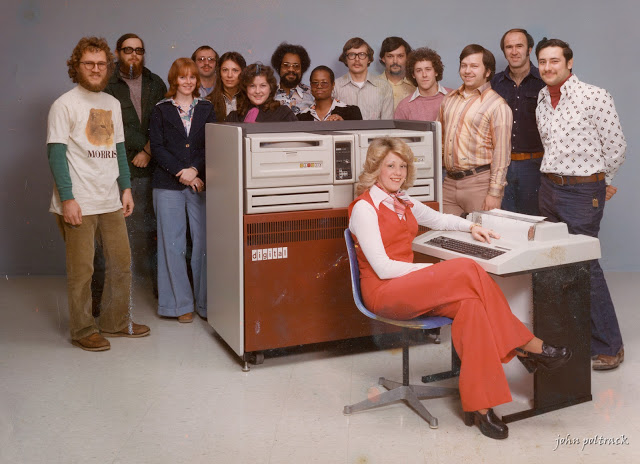
The VAX name was also used by DEC for a family of computer systems based on this processor architecture. The VAX architecture's primary features were virtual addressing (for example demand paged virtual memory) and its orthogonal instruction set.
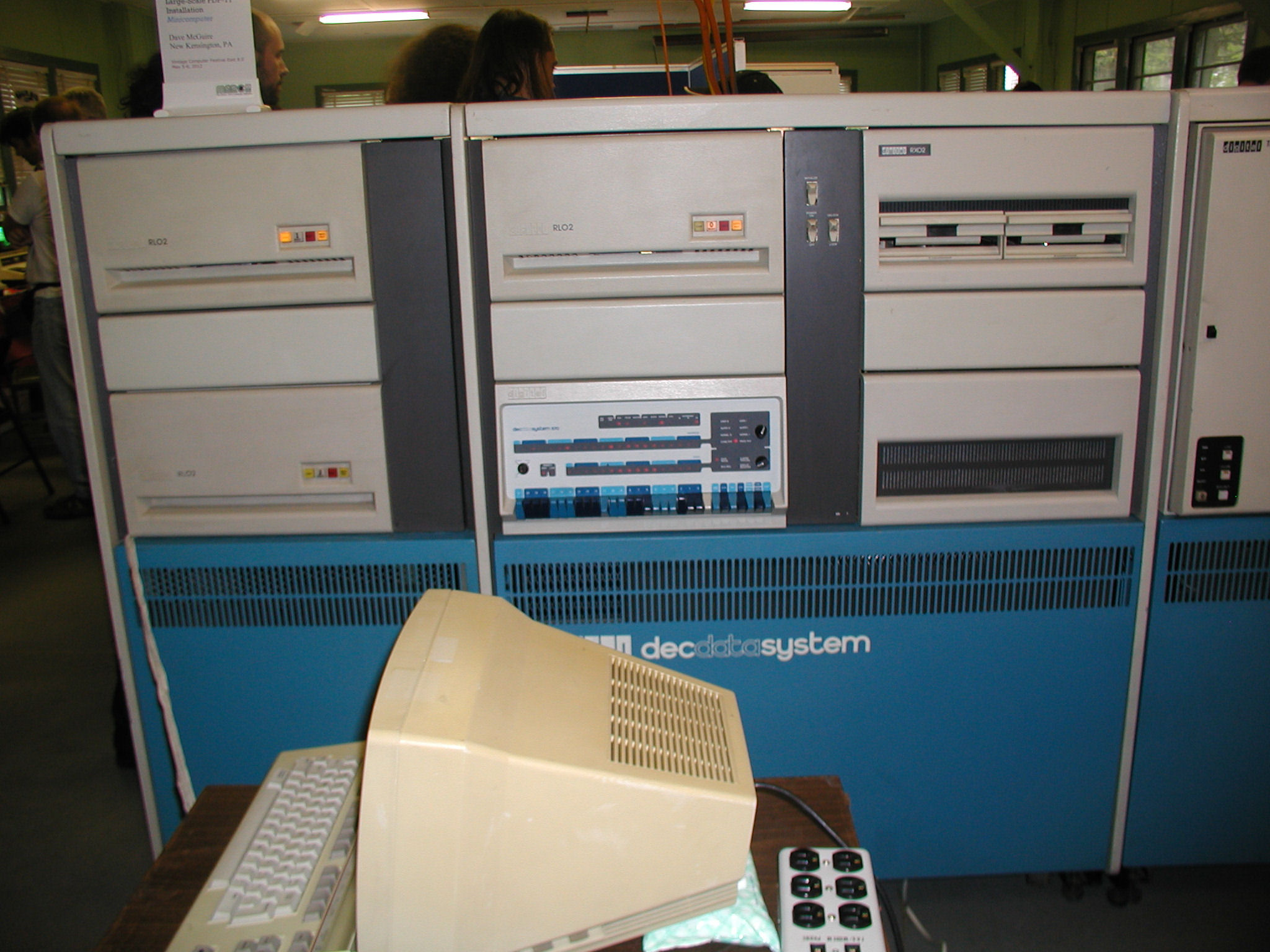
VAX has been perceived as the quintessential CISC ISA, with its very large number of programmer-friendly addressing modes and machine instructions, highly orthogonal architecture, and instructions for complex operations such as queue insertion or deletion and polynomial evaluation.
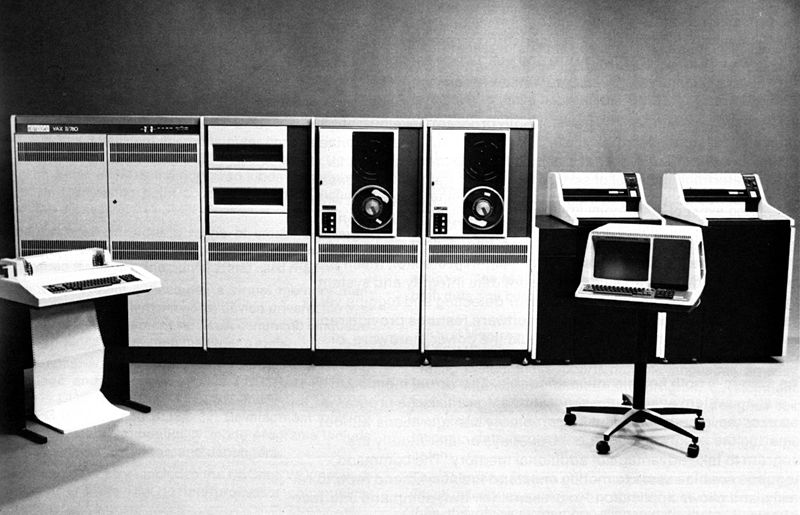
VAX 11/780 (first two cabinet sections), shown with Unibus expansion cabinet (middle cabinet section), two tape drives, two RP05 or RP06 removable pack disk drives, a DECwriter printing terminal, and a VT52 CRT terminal.
"VAX" is originally an acronym for Virtual Address eXtension, both because the VAX was seen as a 32-bit extension of the older 16-bit PDP-11 and because it was (after Prime Computer) an early adopter of virtual memory to manage this larger address space. Early versions of the VAX processor implemented a "compatibility mode" that emulated many of the PDP-11's instructions, and were in fact called VAX-11 to highlight this compatibility and the fact that VAX-11 was an outgrowth of the PDP-11 family. Later versions offloaded the compatibility mode and some of the less used CISC instructions to emulation in the operating system software.
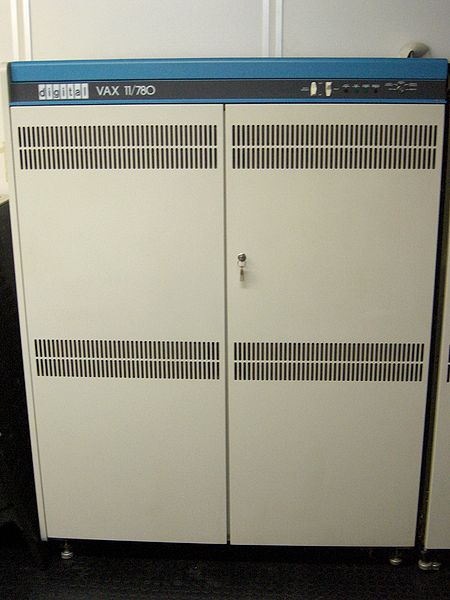 |
Operating systems:
The "native" VAX operating system is DEC's VAX/VMS (renamed to OpenVMS in 1991 or 1992 when it was ported to Alpha, "branded" by the X/Open consortium, and modified to comply with POSIX standards. The VAX architecture and VMS operating system were "engineered concurrently" to take maximum advantage of each other, as was the initial implementation of the VAXcluster facility. Other VAX operating systems have included various releases of BSD UNIX up to 4.3BSD, Ultrix-32, VAXELN and Xinu. More recently, NetBSD and OpenBSD support various VAX models and some work has been done on porting Linux to the VAX architecture.The first VAX model sold was the VAX-11/780, which was introduced on October 25, 1977 at the Digital Equipment Corporation's Annual Meeting of Shareholders. Bill Strecker, C. Gordon Bell's doctoral student at Carnegie-Mellon University, was responsible for the architecture. Many different models with different prices, performance levels, and capacities were subsequently created. VAX superminis were very popular in the early 1980s.
|
|
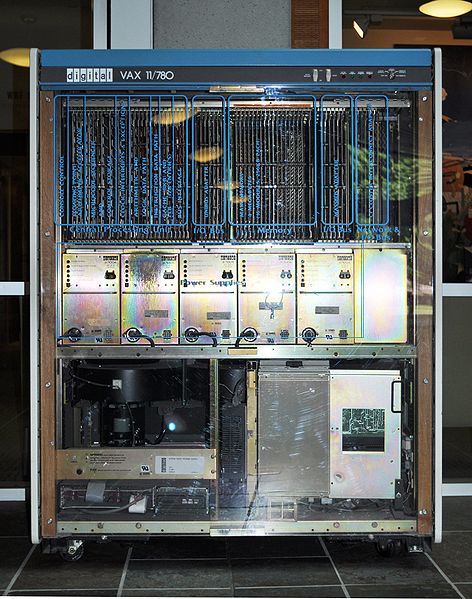 |
For a while the VAX-11/780 was used as a baseline in CPU benchmarks because its speed was about one MIPS. The actual number of instructions executed in 1 second was about 500,000. One VAX MIPS was the speed of a VAX-11/780; a computer performing at 27 VAX MIPS would run the same program roughly 27 times faster than the VAX-11/780. Within the Digital community the term VUP (VAX Unit of Performance) was the more common term, because MIPS do not compare well across different architectures. The related term cluster VUPs was informally used to describe the aggregate performance of a VAXcluster. The performance of the VAX-11/780 still serves as the baseline metric in the BRL-CAD Benchmark, a performance analysis suite included in the BRL-CAD solid modeling software distribution. The VAX-11/780 included a subordinate stand-alone LSI-11 computer that performed booting and diagnostic functions for the parent computer. This was dropped from subsequent VAX models. Enterprising VAX-11/780 users could therefore run programs under three different Digital Equipment Corporation operating systems, VMS and using compatibility mode, RSX-11M, and RT-11 using this subordinate computer.
VAX 8350 front view with cover removed.
|
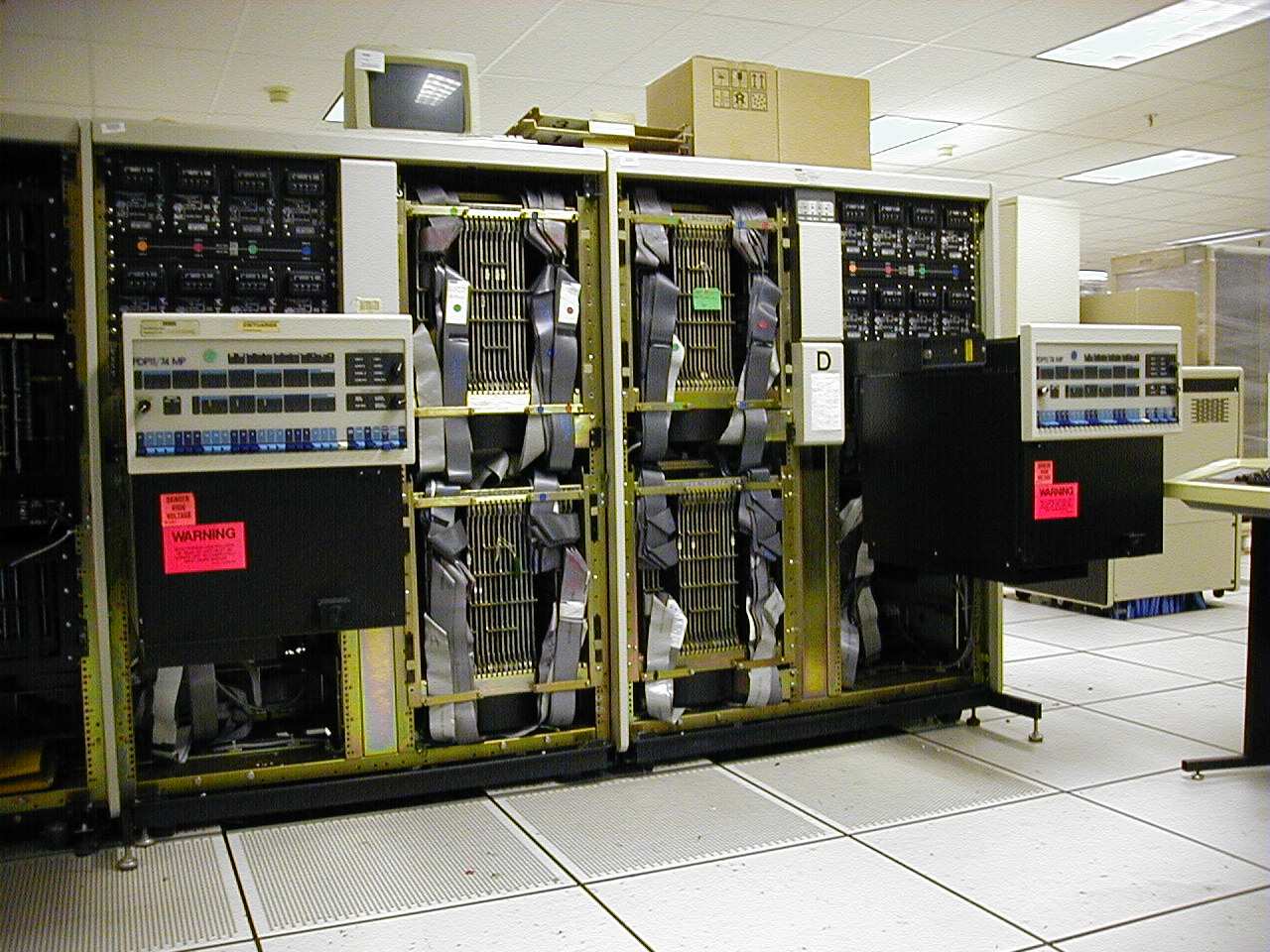
The VAX went through many different implementations. The original VAX was implemented in TTL and filled more than one rack for a single CPU. CPU implementations that consisted of multiple ECL gate array or macrocell array chips included the VAX 8600 and 8800 superminis and finally the VAX 9000 mainframe class machines. CPU implementations that consisted of multiple MOSFET custom chips included the 8100 and 8200 class machines.
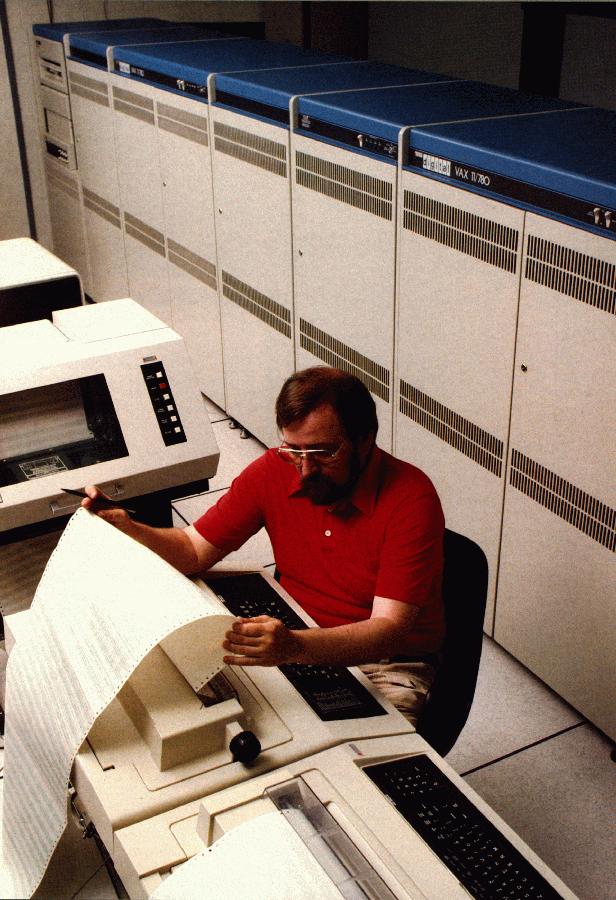 |
|
The VAX architecture was eventually superseded by RISC technology. In 1989 DEC introduced a range of workstations and servers that ran Ultrix, the DECstation and DECsystem respectively, based on processors that implemented the MIPS architecture. In 1992 DEC introduced their own RISC instruction set architecture, the Alpha AXP (later renamed Alpha), and their own Alpha-based microprocessor, the DECchip 21064, a high performance 64-bit design capable of running OpenVMS.
|
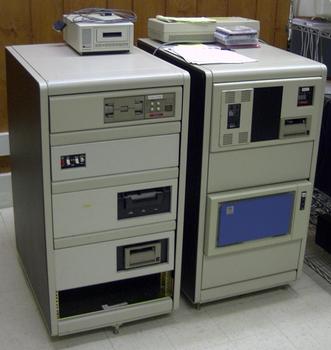 |
The DEC microVAX II systems. I used to have a VAX-11/750 and a smattering of PDP-11/23's and 73's. The box on the left cabinet is a 2 GB helical scan 8mm tape drive. The box on the right cabinet is a thicknet to thinnet adapter. |
A full VLSI (microprocessor) implementation of the MicroVAX architecture then arrived with the MicroVAX II's 78032 (or DC333) CPU and 78132 (DC335) FPU. The 78032 was the first microprocessor with an on-board memory management unit. The MicroVAX II was based on a single, quad-sized processor board which carried the processor chips and ran the MicroVMS or Ultrix-32 operating systems. The machine featured 1 MB of on-board memory and a Q22-bus interface with DMA transfers. The MicroVAX II was succeeded by many further MicroVAX models with much improved performance and memory.
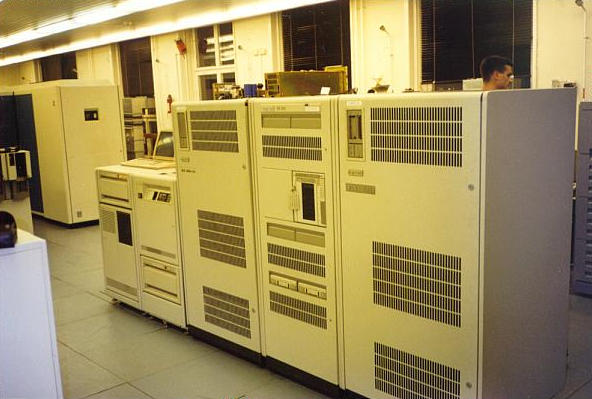
The MicroVAX I represented a major transition within the VAX family. At the time of its design, it was not yet possible to implement the full VAX architecture as a single VLSI chip (or even a few VLSI chips as was later done with the V-11 CPU of the VAX 8200/8300). Instead, the MicroVAX I was the first VAX implementation to move most of the complexity of the VAX instruction set into emulation software, preserving just the core instructions in hardware. This new partitioning substantially reduced the amount of microcode required and was referred to as the "MicroVAX" architecture. In the MicroVAX I, the ALU and registers were implemented as a single gate-array chip while the rest of the machine control was conventional logic.
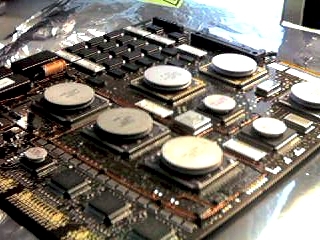 |
|
Further VLSI VAX processors followed in the form of the V-11, CVAX, SOC ("System On Chip", a single-chip CVAX), Rigel, Mariah and NVAX implementations. The VAX microprocessors extended the architecture to inexpensive workstations and later also supplanted the high-end VAX models. This wide range of platforms (mainframe to workstation) using one architecture was unique in the computer industry at that time. Sundry graphics were etched onto the CVAX microprocessor die. The phrase CVAX... when you care enough to steal the very best was etched in broken Russian as a play on a Hallmark Cards slogan, intended as a message to Soviet engineers who were known to be both purloining DEC computers for military applications, along with reverse engineering their chip design.
|
The 1990s had downsized the computer industry; Digital was no exception. Between 1991 and 1994, the firm lost over $4 billion. At the end of the 1994 fiscal year (June), Digital reported yearly operating revenues of $13.5 billion, down 6% from 1993, an annual net loss of over $2 billion (including restructuring charges of $1.2 billion), and 85,000 employees. The firm's cost structure was higher than average for its industry. Gross margins on products had declined due to pricing and a continued shift in mix to low-end, low-margin products.
Eventually, on 26 January 1998, what remained of the company (including Digital's multivendor global services organization and customer support centers) was sold to Compaq, which was acquired by Hewlett-Packard in 2002. The remainder of Digital Semiconductor (the Alpha microprocessor group) was sold to Intel, which placed those employees back in their Hudson, Mass. office which they had vacated when the site was sold to Intel in 1997. Compaq, and later HP, continued to sell many of the former Digital products but rebranded with their own logos. For example, HP now sells what were formerly Digital's StorageWorks disk/tape products, as a result of the Compaq acquisition.
 |
The Digital logo survived for a while after the company ceased to exist, as the logo of Digital GlobalSoft, an IT services company in India (which was a 51 percent subsidiary of Compaq). Digital GlobalSoft was later renamed "HP GlobalSoft" and no longer uses the Digital logo. |
The digital.com and DEC.com domain names are now owned by Hewlett-Packard and redirect to their US website. Digital once held the Class A IP address block 16.0.0.0/8.

The Digital Federal Credit Union (DCU, now DFCU), which was chartered in 1979 for employees of DEC, is now open to essentially everyone. DFCU has over 700 different sponsors, including the companies that acquired pieces of DEC.
In August 2000, Compaq announced that the remaining VAX models would be discontinued by the end of the year. By 2005 all manufacturing of VAX computers had ceased, but old systems remain in widespread use.
The SRI CHARON-VAX and SIMH software-based VAX emulators remain available today.

